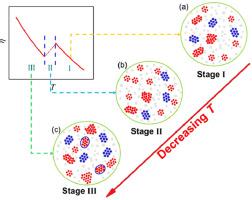当前位置:
X-MOL 学术
›
Acta Mater.
›
论文详情
Our official English website, www.x-mol.net, welcomes your
feedback! (Note: you will need to create a separate account there.)
Generality of abnormal viscosity drop on cooling of CuZr alloy melts and its structural origin
Acta Materialia ( IF 8.3 ) Pub Date : 2020-09-01 , DOI: 10.1016/j.actamat.2020.07.018 Wei Chu , Jixiang Shang , Kuibo Yin , Nannan Ren , Lina Hu , Yunbo Zhao , Bangshao Dong
Acta Materialia ( IF 8.3 ) Pub Date : 2020-09-01 , DOI: 10.1016/j.actamat.2020.07.018 Wei Chu , Jixiang Shang , Kuibo Yin , Nannan Ren , Lina Hu , Yunbo Zhao , Bangshao Dong

|
Abstract It has been widely accepted that the viscosity of alloy melts increases monotonically with temperature decreasing after exceeding the liquidus temperature. However, a distinct viscosity-drop has been observed in several alloy melts in our previous works. To further understand this dynamic anomaly, we investigated the viscosity of CuZrAl and CuZrTiNi melts by gradually changing the compositions of alloy systems. The results suggest that when the amounts of doping elements (Al, Ti, Ni) become large enough, this abnormal viscosity-drop disappears. For CuZr binary alloys, the anomaly exists when the composition of Zr ranges between 27.3–66.7%, which nearly corresponds to the available content of Zr in CuZr bulk metallic glasses. By conducting molecular dynamics simulation, the mechanism that four icosahedron-like clusters with high fragility evolves with temperature in Cu62Zr38 melts has been recognized. In contrast to general aggregation or growth of clusters during cooling process, an unexpected tendency that more segregations are formed among these clusters and the clusters become further dispersed in liquids has been discovered around 1400 K; meanwhile, the viscosity-drop in our experiments begins simultaneously at this temperature. Below 1300 K, these icosahedron-like clusters aggregate abruptly again. Experimental results from differential scanning calorimeter (DSC) and high-resolution transmission electron microscope (HRTEM) further approve the influence of these fragile icosahedron-like clusters on crystallization processes. This finding uncovers the same structural origin that underlies both the formation of bulk metallic glasses and the dynamic anomaly in melts, and demonstrates the dominant role of fragile icosahedron-like clusters in the feature of liquid dynamics.
中文翻译:

CuZr合金熔体冷却异常粘度下降的一般性及其结构起源
摘要 合金熔体的粘度在超过液相线温度后随温度的降低而单调增加已被广泛接受。然而,在我们之前的工作中,在几种合金熔体中观察到了明显的粘度下降。为了进一步了解这种动态异常,我们通过逐渐改变合金系统的成分来研究 CuZrAl 和 CuZrTiNi 熔体的粘度。结果表明,当掺杂元素(Al、Ti、Ni)的量足够大时,这种异常的粘度下降就会消失。对于 CuZr 二元合金,当 Zr 的成分范围在 27.3-66.7% 之间时存在异常,这几乎对应于 CuZr 块状金属玻璃中 Zr 的可用含量。通过进行分子动力学模拟,四个具有高脆性的类二十面体团簇在Cu62Zr38熔体中随温度演化的机制已经被认识。与冷却过程中团簇的一般聚集或生长相反,在 1400 K 左右发现了在这些团簇之间形成更多偏析并且团簇进一步分散在液体中的意外趋势;同时,我们实验中的粘度下降同时在该温度下开始。低于 1300 K,这些二十面体状星团再次突然聚集。差示扫描量热仪 (DSC) 和高分辨率透射电子显微镜 (HRTEM) 的实验结果进一步证实了这些易碎的二十面体状簇对结晶过程的影响。
更新日期:2020-09-01
中文翻译:

CuZr合金熔体冷却异常粘度下降的一般性及其结构起源
摘要 合金熔体的粘度在超过液相线温度后随温度的降低而单调增加已被广泛接受。然而,在我们之前的工作中,在几种合金熔体中观察到了明显的粘度下降。为了进一步了解这种动态异常,我们通过逐渐改变合金系统的成分来研究 CuZrAl 和 CuZrTiNi 熔体的粘度。结果表明,当掺杂元素(Al、Ti、Ni)的量足够大时,这种异常的粘度下降就会消失。对于 CuZr 二元合金,当 Zr 的成分范围在 27.3-66.7% 之间时存在异常,这几乎对应于 CuZr 块状金属玻璃中 Zr 的可用含量。通过进行分子动力学模拟,四个具有高脆性的类二十面体团簇在Cu62Zr38熔体中随温度演化的机制已经被认识。与冷却过程中团簇的一般聚集或生长相反,在 1400 K 左右发现了在这些团簇之间形成更多偏析并且团簇进一步分散在液体中的意外趋势;同时,我们实验中的粘度下降同时在该温度下开始。低于 1300 K,这些二十面体状星团再次突然聚集。差示扫描量热仪 (DSC) 和高分辨率透射电子显微镜 (HRTEM) 的实验结果进一步证实了这些易碎的二十面体状簇对结晶过程的影响。











































 京公网安备 11010802027423号
京公网安备 11010802027423号